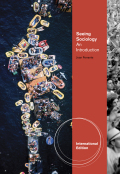
With SEEING SOCIOLOGY: AN INTRODUCTION, International Edition, respected author and award-winning professor Joan Ferrante offers students an exciting and fresh introduction to sociology in which the visual and text narratives are profoundly interwoven. Sociology's relevance to daily life is illustrated throughthe use of everyday images and pictures. These "SocScenes" allow students to read about and visually apply sociological concepts. The easy-to-manage, modular table of contents allows for flexibility and synthesis of information. INDICE: 1. THE SOCIOLOGICAL IMAGINATION. Module 1: What is Sociology? Module 2: Social Facts. Module 3: The Sociological Imagination. Module 4: The Emergence of Sociology. Module 5: The Early Sociologists. Module 6: Sociological Theory. Module 7: Research Design. Module 8: Steps of Social Research. Summary:Putting It All Together and Can You Top This Photo? 2. CULTURE. Module 1: Culture. Module 2: Material and Nonmaterial Culture. Module 3: Cultural Diversity. Module 4: Encountering Cultures. Module 5: Cultural Diffusion. Module 6: Applying Theory: Global Society Theories. Summary: Putting It All Together and Can You Top This Photo? The Research Question: How Does A Foreign Practice Take Root? 3. SOCIALIZATION. Module 1: Socialization. Module 2: Nature and Nurture.Module 3: The Social Self. Module 4: The Life Course and Transitions. Module 5: Agents of Socialization. Module 6: Applying Theory: The Three Perspectives.Summary: Putting It All Together and Can You Top This Photo? The Research Question: To Whom do Americans Talk About Important Matters? 4. SOCIAL STRUCTURES. Module 1: Defining Social Structure. Module 2: Division of Labor and Social Networks. Module 3: Formal Organizations. Module 4: The Effects of Size. Module 5: Rationalization and McDonaldization. Module 6: Workplaces. Module 7: Applying Theory: Dramaturgy and Emotional Labor. Summary: Putting It All Together and Can You Top This Photo? The Research Question: How Do Organizations Promote Altruistic Behavior? 5. CONSTRUCTING REALITY. Module 1: Definition of the Situation. Module 2: Attribution Theory. Module 3: Dramaturgical Approach. Module 4: Ethnomethodology. Module 5: Reference Groups. Module 6: Ingroups and Outgroups. Module 7: Applying Theory: Phenomenology. Summary: Putting It All Together and Can You Top This Photo? The Research Question: How Does On-Line DatingShape Intimate Relationships? 6. DEVIANCE. Module 1: Defining Deviance. Module 2: Mechanisms of Social Control. Module 3: Labeling Theory. Module 4: Differential Association. Module 5: Structural Strain Theory. Module 6: Medicalization of Deviance. Module 7: Crime. Module 8: Applying Theory: Poststructural Theories: Foucault's Disciplinary Society. Summary: Putting It All Together and Can You Top This Photo? The Research Question: Can Gangs Have a Purpose? 7. SOCIAL STRATIFICATION. Module 1: Conceptualizing Social Stratification. Module 2:Social Class. Module 3: Global Inequality. Module 4: Responses to Global Inequality. Module 5: Inequality. Module 6: Poverty and Its Functions. Module 7: The Truly Disadvantaged in the U.S. Module 8: Applying Theory: Critical Social Theory. Summary: Putting It All Together and Can You Top This Photo? The Research Question: How Do Food Menus Reflect Social Class? 8. RACE AND ETHNICITY. Module 1: Race. Module 2: Ethnic Groups. Module 3: Classifying Race and Ethnicity. Module 4: Minority Groups. Module 5: Racism. Module 6: Prejudice and Discrimination. Module 7: Assimilation, Integration, and Pluralism. Module 8: Applying Theory: The Three Perspectives. Summary: Putting It All Together and Can You Top This Photo? The Research Question: Why Do Some People Give InconsistentAnswers to Race Questions? 9. GENDER. Module 1: Sex and Gender. Module 2: Gender Polarization and Life Chances. Module 3: Gender Stratification. Module 4: Gender Socialization. Module 5: Sexuality and Sexual Orientation. Module 6: Sexism and Feminism. Module 7: Applying Theory: The Three Perspectives. Summary:Putting It All Together and Can You Top This Photo? The Research Question: How Do We Document and Explain the Global-Scale Subordination of Women? 10. ECONOMICS AND POLITICS. Module 1: Economic Systems. Module 2: The U.S. Economy. Module 3: Multinational and Global Corporations. Module 4: Power and Authority. Module 5: Forms of Government. Module 6: Imperialism and Related Concepts. Module 7: Applying Theory: Global Society Theories. Summary: Putting It All Together and Can You Top This Photo? The Research Question: Do Internet Skills Increase Wages? 11. FAMILIES AND CAREGIVING. Module 1: Defining Family. Module 2: Family Structures in Three Countries. Module 3: Family Structures in the United States. Module 4: Sexual Stratification. Module 5: Intergenerational Family Relationships. Module 6: Who Needs and Gives Care? Module 7: Applying Theory: Critical Social Theory. Summary: Putting It All Together and Can You Top This Photo? The Research Question: What Does It Mean to Be Single? 12. EDUCATION AND RELIGION. Module 1: Education. Module 2: The Curriculum. Module 3: Learning Environments. Module 4: Costs and Rewards of Higher Education. Module 5: Religion. Module 6: Civil Religion and Fundamentalism. Module 7: Applying Theory: Contemporary Theoretical Syntheses. Summary: Putting It All Together and Can You Top This Photo? The Research Question: What Does "Acting White" Mean to Low-Income Minority Youth? 13. THE CHANGING ENVIRONMENT. Module 1: Social Change. Module 2: Human Societies and Carbon Footprints. Module 3: Population Dynamics. Module 4: Social Movements. Module 5: Environmental Sociology. Module 6: Applying Theory: Rational Choice Theory. Summary: Putting It All Together and CanYou Top This Photo? The Research Question: Should We Drill For Oil In Alaska?14. SOCIOLOGY IN FOREFRONT. Module 1: Human-Animal Relationships. Module 2: Commercialization of Childhood. Module 3: Tattoos and Body Piercing as Expressions of Identity. Module 4: Assessing a Public Health Policy. Module 5: Gender Transitions in the Workplace. Module 6: Stepping Outside Comfort Zones.
- ISBN: 978-0-8400-3203-4
- Editorial: Wadsworth
- Encuadernacion: Rústica
- Páginas: 608
- Fecha Publicación: 11/08/2010
- Nº Volúmenes: 1
- Idioma: Inglés
